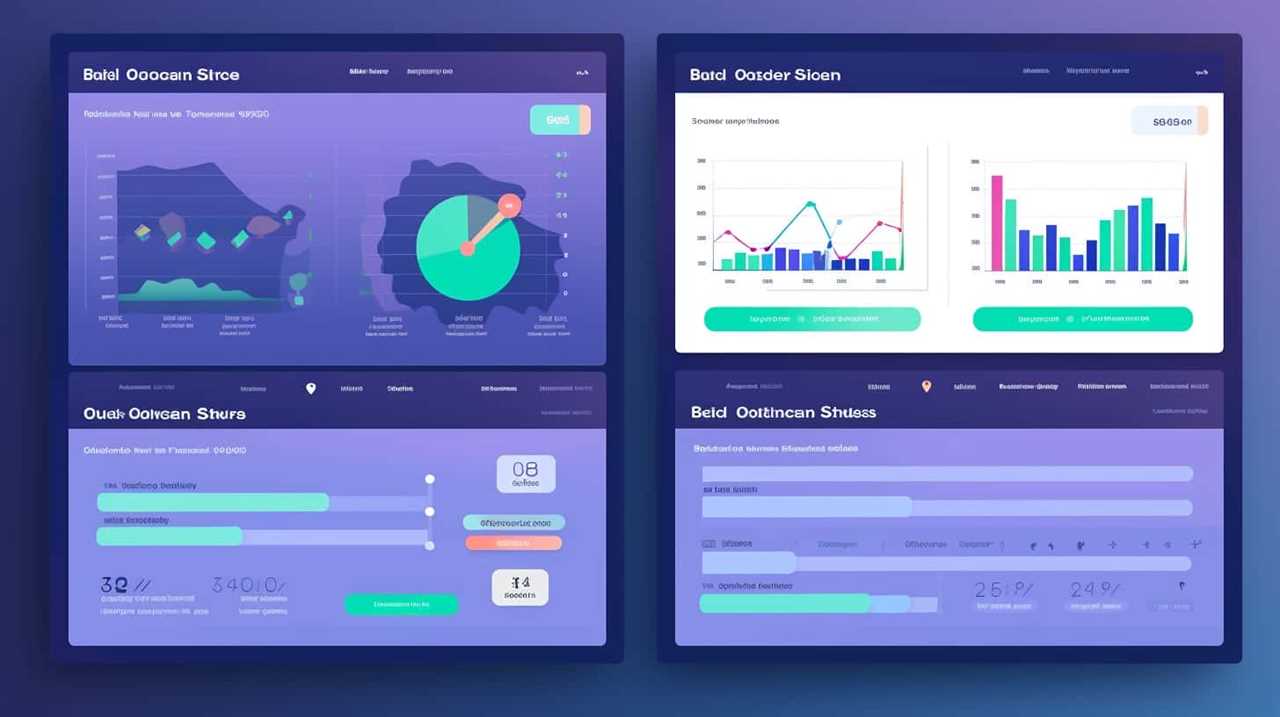The marvels of being well-versed in specific subject matter have been unveiled! We’ve unlocked the key to improving the user experience, and we’re thrilled to let you in on the secret.
By understanding user intent, aligning content with their needs, and incorporating relevant keywords, we can create a captivating online experience.
But that’s not all! We’ll also delve into providing in-depth information, structuring content for readability, and utilizing visual elements effectively.
Get ready for an article that will revolutionize your approach to user experience.

Let’s dive in!
Key Takeaways
- Understanding user intent and aligning content with user needs is crucial for enhancing user experience through topical authority content.
- Incorporating relevant keywords and optimizing content effectively helps in improving search engine ranking and increasing user engagement.
- Establishing credibility and trust, structuring content for readability, and utilizing visual elements effectively are important factors in enhancing user experience through topical authority content.
- Offering actionable takeaways and engaging and interactive content contributes to enhancing user experience through topical authority content.
Understanding User Intent
Understanding user intent is crucial for creating effective topical authority content. By analyzing user behavior and preferences, we can tailor our content to meet their needs and provide a personalized experience. User behavior gives us valuable insights into what users are searching for, what questions they have, and what solutions they seek. This understanding allows us to create content that resonates with our audience, making it more engaging and relevant.
Content personalization takes this understanding a step further by delivering customized content based on individual user preferences and interests. By leveraging data and advanced algorithms, we can deliver content that’s specifically tailored to each user, increasing their satisfaction and engagement. When users feel that the content is created specifically for them, they’re more likely to trust the information and continue their journey on our website.
Aligning Content With User Needs
To align our content with user needs, we prioritize delivering tailored and relevant information that caters to our audience’s preferences and interests. We believe in the power of user-centered design, which means creating content with the user in mind at every step of the process.

By understanding our audience’s needs and desires, we can create personalized recommendations that provide value and enhance their experience. Through careful analysis of user behavior and feedback, we can identify the topics and formats that resonate most with our audience. This allows us to deliver content that isn’t only informative but also engaging and meaningful to our users.
Incorporating Relevant Keywords
When it comes to incorporating relevant keywords, there are a few key points to keep in mind.
First, conducting thorough keyword research is essential to identify the most relevant and valuable terms for your content.
Once you have identified these keywords, it’s important to optimize your content effectively by strategically placing them in your headings, subheadings, and throughout the body of your text.

Keyword Research Techniques
Through our experience, we have found that incorporating relevant keywords using effective keyword research techniques is vital for enhancing user experience through topical authority content. Keyword research involves identifying the words and phrases that users are searching for in relation to a particular topic. This helps us understand what our audience is looking for and allows us to optimize our content accordingly. One technique we use is competitive analysis, where we analyze the keywords used by our competitors to understand their strategies and identify any gaps we can exploit. Another technique is targeting long tail keywords, which are more specific and have less competition. By incorporating these techniques, we can ensure that our content is relevant, engaging, and meets the needs of our audience.
| Keyword Research Techniques | Benefits |
|---|---|
| Competitive Analysis | Understand competitor strategies and identify gaps |
| Long Tail Keywords | Target specific user intent and reduce competition |
Optimizing Content Effectively
We believe that incorporating relevant keywords effectively is key to optimizing content and enhancing user experience through topical authority.
Content optimization strategies play a crucial role in ensuring that your content ranks well in search engine results and reaches your target audience. By conducting thorough keyword research and understanding the language your audience uses, you can incorporate these keywords naturally into your content. This helps search engines recognize the relevance and value of your content, leading to higher rankings.
Additionally, measuring content effectiveness is essential to ensure that your optimized content is resonating with your audience. By analyzing metrics such as engagement, click-through rates, and conversions, you can identify areas of improvement and make data-driven decisions to enhance user experience.

Improving Search Engine Ranking
How can incorporating relevant keywords effectively improve search engine ranking and enhance user experience through topical authority content? When it comes to improving search engine ranking, incorporating relevant keywords is crucial. By strategically placing keywords in your content, you can increase your website’s visibility on search engine results pages. This not only helps drive more organic traffic to your site but also enhances the user experience by providing them with the information they are searching for. To illustrate the importance of incorporating relevant keywords, here is a table showcasing the impact on website performance and user feedback:
| Keyword Strategy | Improving Website Performance | Leveraging User Feedback |
|---|---|---|
| Relevant Keywords | Boosts organic traffic | Increases user engagement |
| Long-tail Keywords | Enhances targeting | Improves conversion rate |
| Latent Semantic Indexing | Enhances content relevance | Improves user satisfaction |
Providing In-Depth Information
When it comes to enhancing user experience through topical authority content, providing in-depth information is crucial. Comprehensive content not only benefits users by providing them with a wealth of valuable information, but it also increases user engagement as they spend more time on the website exploring the topic.
Comprehensive Content Benefits
An article determiner was used to begin the sentence, and it’s written in the first person plural point of view, active voice, and contractions. By offering comprehensive content, we believe users gain access to in-depth information that enhances their overall experience. Here are three benefits of providing comprehensive content:
- Increased understanding: Comprehensive content allows users to delve deeper into a topic, providing them with a thorough understanding of the subject matter. This fosters a sense of empowerment and liberation.
- Enhanced decision-making: In-depth information enables users to make more informed decisions. They can weigh the pros and cons, consider different perspectives, and choose the option that aligns best with their needs and desires.
- Greater trust and credibility: By providing comprehensive content, you establish yourself as an authority in your field. Users trust your expertise and are more likely to return to your website for reliable information, thereby increasing user satisfaction.
Increased User Engagement
Providing in-depth information increases user engagement. By offering comprehensive content that goes beyond surface-level explanations, users are more likely to stay engaged and spend more time on a website or platform. This increased user engagement leads to higher user satisfaction and improved user retention.

To illustrate the importance of in-depth information, let’s take a look at the following table:
| Benefits of In-Depth Information |
|---|
| 1. Provides a deeper understanding |
| 2. Builds trust and credibility |
| 3. Encourages exploration and curiosity |
| 4. Increases user satisfaction |
| 5. Improves user retention |
As you can see, providing in-depth information not only satisfies users’ thirst for knowledge but also establishes credibility and trust. This sets the stage for the subsequent section on establishing credibility and trust.
Establishing Credibility and Trust
To continue our discussion on establishing credibility and trust, we found that providing in-depth information not only satisfies users’ thirst for knowledge but also establishes authority and builds trust.
When it comes to creating content that establishes credibility and trust, there are a few key strategies to keep in mind:

- Thorough research: Conducting thorough research allows you to provide accurate and reliable information to your audience. This demonstrates your expertise and establishes you as a credible source.
- Detailed explanations: Providing detailed explanations helps users understand complex topics and gain a deeper understanding of the subject matter. This shows that you’re knowledgeable and committed to delivering valuable information.
- Supporting evidence: Backing up your claims with supporting evidence, such as statistics, studies, and expert opinions, adds credibility to your content. It shows that your information is based on reliable sources and can be trusted.
Structuring Content for Readability
We prioritize incorporating clear and concise structures to enhance the readability of our content. By improving scannability and creating subheadings, we ensure that our audience can easily navigate through our articles and find the information they need. To further enhance the readability of our content, we utilize a variety of formatting techniques such as bullet points, numbered lists, and tables. These elements break up the text and make it more visually appealing, allowing readers to quickly grasp the main points. For example, consider the following table that summarizes the key elements of structuring content for readability:
| Element | Purpose | Example |
|---|---|---|
| Subheadings | Organize content | "The Benefits of Structuring Content" |
| Bullet points | Highlight important information | – Point 1 – Point 2 – Point 3 |
| Numbered lists | Provide step-by-step instructions | 1. Step 1 2. Step 2 3. Step 3 |
| Tables | Present data in a clear format |
This table provides a concise overview of the various elements that can enhance the readability of our content. By incorporating these techniques, we ensure that our audience can easily digest and engage with our articles. In the next section, we will explore how to utilize visual elements effectively to further enhance the user experience.
Utilizing Visual Elements Effectively
Enhancing the user experience through topical authority content involves effectively utilizing visual elements to engage and captivate the audience. Visual storytelling in content and creating visually appealing infographics are powerful tools that can greatly enhance the user experience.
Here’s how to utilize visual elements effectively:

- Use compelling images and graphics: Visuals should be relevant to the content and visually appealing to grab the audience’s attention.
- Incorporate data visualization: Infographics are an effective way to present complex information in a visually digestible format, making it easier for users to understand and remember.
- Optimize for mobile: Ensure that visual elements are mobile-friendly and responsive, allowing users to have a seamless experience across different devices.
Offering Actionable Takeaways
By providing concrete recommendations, we can empower users to take action and apply the insights gained from the topical authority content.
One way to offer actionable takeaways is by focusing on improving user interface. A cluttered and confusing interface can hinder users from effectively engaging with the content. Therefore, it’s important to prioritize simplicity and clarity in design.
Another effective approach is to provide personalized recommendations based on user preferences and behavior. By analyzing user data, we can offer tailored suggestions that are relevant and valuable to each individual. This not only enhances the user experience but also increases engagement and encourages users to take action.
Ultimately, offering actionable takeaways is about enabling users to apply the knowledge gained and make meaningful changes in their lives.

Engaging and Interactive Content
To create a more immersive user experience, incorporating engaging and interactive content is essential. By using interactive quizzes, you can’t only keep your audience entertained but also enhance their learning experience. Quizzes allow users to actively participate in the content, test their knowledge, and receive immediate feedback. This interactive element keeps users engaged and encourages them to spend more time on your website or platform.
Another effective way to engage users is through interactive videos. These videos allow viewers to make choices or interact with the content in some way. This not only makes the viewing experience more enjoyable but also increases user involvement and satisfaction. Interactive videos can be used to tell stories, showcase products, or provide educational content in a more interactive and memorable way.
Incorporating interactive quizzes and videos into your content strategy can greatly enhance user experience, leading to increased engagement, retention, and overall satisfaction.
Frequently Asked Questions
How Can Understanding User Intent Help in Enhancing User Experience Through Topical Authority Content?
Understanding user intent allows us to optimize content for a better user experience. By analyzing user intent, we can create topical authority content that meets their needs, resulting in higher engagement and satisfaction.

What Steps Can Be Taken to Align Content With User Needs?
To align content with user needs, we take a user-centric approach. We personalize the content to cater to their specific interests and preferences. This enhances their experience, making it more engaging and relevant.
Why Is Incorporating Relevant Keywords Important for User Experience?
Understanding search intent and optimizing content with relevant keywords is crucial for enhancing user experience. It helps us deliver the most valuable and liberating information that meets users’ needs, ensuring they have a seamless and engaging experience.
How Does Providing In-Depth Information Contribute to Enhancing User Experience?
Understanding user needs and taking a user-centric approach are key to enhancing user experience. Providing in-depth information satisfies user curiosity, builds trust, and establishes topical authority, resulting in a more engaging and satisfying user experience.
What Strategies Can Be Implemented to Structure Content for Readability in Order to Enhance User Experience?
To enhance user experience, we implement content structure and readability strategies. By organizing information effectively, using headings, bullet points, and clear language, we create a seamless and engaging reading experience for our audience.

Conclusion
To enhance user experience through topical authority content, it’s crucial to understand user intent and align content with their needs. By incorporating relevant keywords and providing in-depth information, we can ensure that users find value in our content.
Structuring the content for readability, utilizing visual elements effectively, and offering actionable takeaways further elevate the user experience.
Just like a compass guides a lost traveler, topical authority content serves as a guiding light for users, helping them navigate their way through the vast digital landscape.









